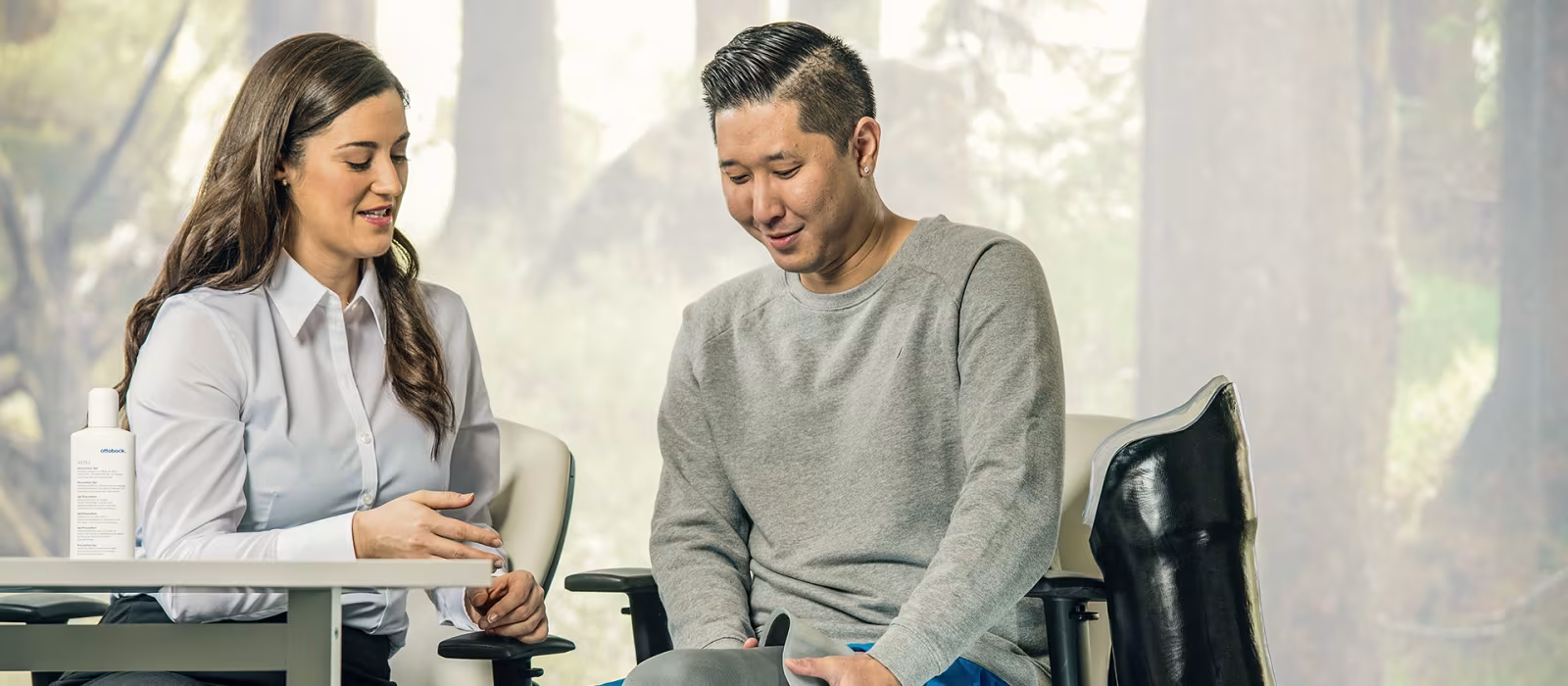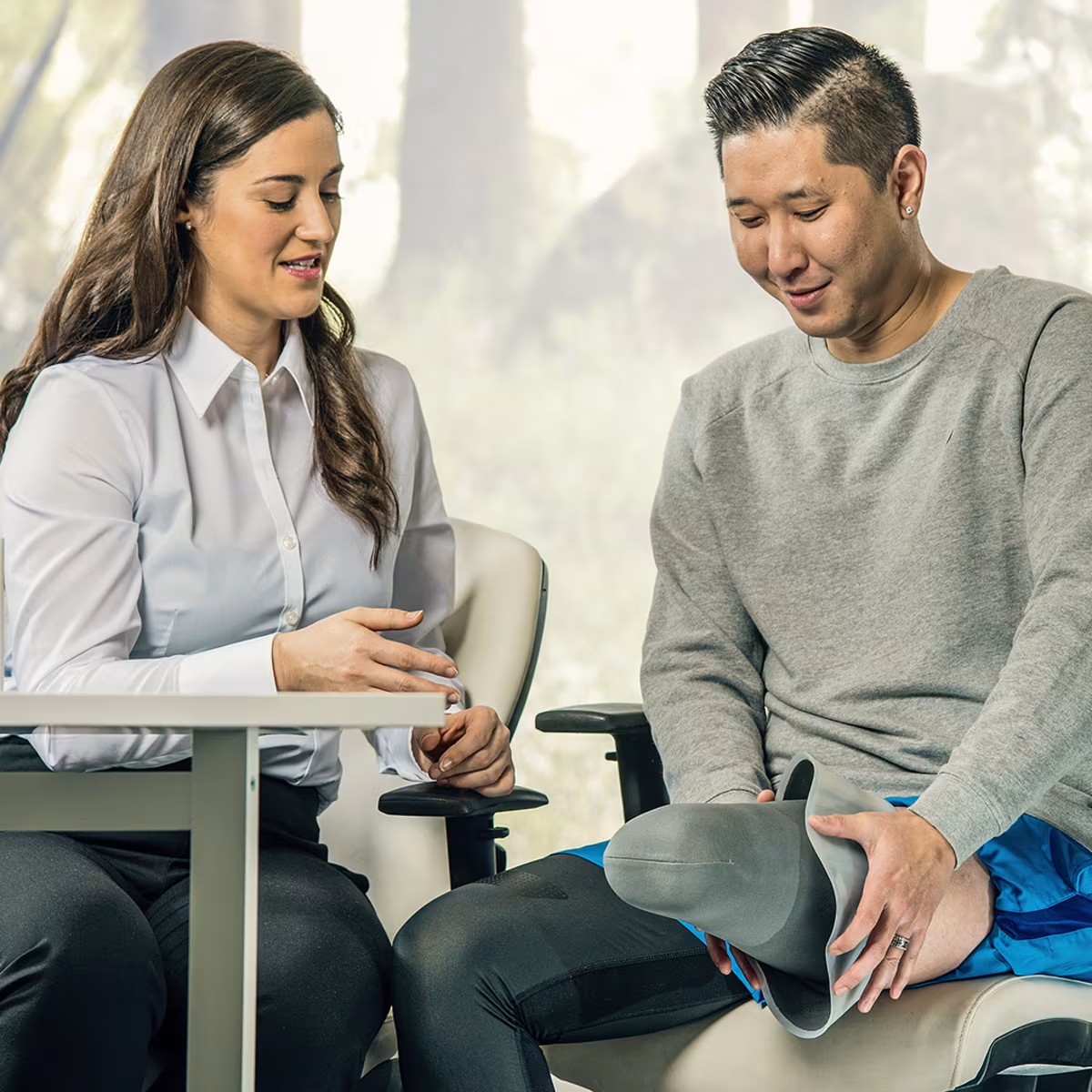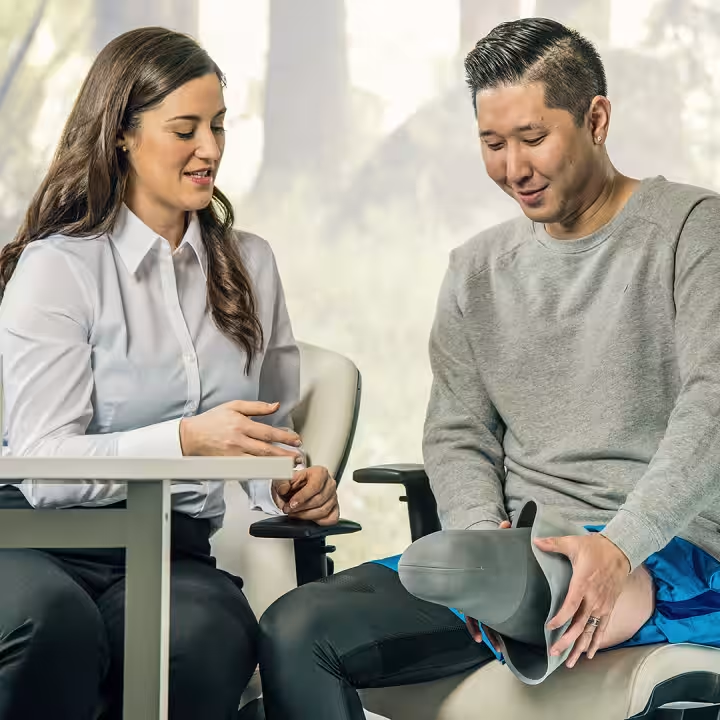


Prosthetic fitting
Prepare your patient for a first prosthetic fitting by restoring your patient’s mobility and explain components of a prosthetic legs.
Prepare your patient for a first prosthetic fitting by restoring your patient’s mobility and explain components of a prosthetic legs.
Restoring your patient's mobility
After the acute phase of their recovery, your patient will be ready to move on to the next key step in their rehabilitation: being fitted for a prosthesis and learning how to walk on it.
They’ll typically begin that process with an interim prosthesis manufactured during the postoperative period, after their surgical wound has healed. Most patients will use their interim prosthesis until the volume and musculature of their residual limb have both stabilized.
This period gives your O&P team an opportunity to explore the optimal socket fit and identify the right components for a long-term prosthesis.

Components of a prosthesis
When it comes to selecting components for a lower-limb prosthesis, today’s O&P teams can choose from a wide variety of products, construction techniques, and functions. The right combination for each patient will differ depending on their amputation, residual limb, and physical capability.
The two most common lower limb amputations — transtibial (TT) and transfemoral (TF) — typically require some combination of the following components:
A prosthetic socket that creates a secure, comfortable connection between the patient’s residual limb and their prosthesis
A socket liner and suspension system that keep the prosthesis in place while the patient is walking
A prosthetic knee joint (TF only) that helps control the patient’s gait and stance
A prosthetic foot (TT and TF) that provides safety and stability while the patient is standing or walking
Adapters that help keep the patient’s prosthesis in position during daily activities
Cosmetic covers that help a prosthesis look more natural and blend in with a patient’s overall look
The prosthetic socket
This critical component forms the connection between the amputee's residual limb and the rest of their prosthesis. Each socket is built specifically for its wearer, usually using light, durable materials like carbon, silicone, or lamination resin.
The socket has three critical functions that help ensure a safe, comfortable walking experience:
Supporting load transfer and ensuring that axial forces are evenly distributed when the user is walking
Stabilizing the user by absorbing horizontal forces that can otherwise cause the residual limb to tilt back and forth in the socket
Adhering to the user to ensure a firm, consistent connection between the residual limb and socket during swing phase

Socket liner & suspension system
These two components define the connection between the user’s residual limb and prosthetic socket. Together, they ensure that the socket doesn’t slip off the user’s residual limb while walking.
Suspension systems usually work with specific liners and are typically designed to work in one of two ways: either through negative pressure (a vacuum seal) or using a mechanical setup. The right system for each user often depends on the shape and height of their residual limb.

The prosthetic knee (TF only)
This replacement joint is a critical component of any prosthetic solution for users with an above-knee amputation. Prosthetic knees come in multiple different formats, but typically fall into one of three groups defined by how the joint functions under load:
No flexion under load, e.g., locking/brake knees, 4-axis polycentric knees, mechanical monocentric knees with no stance control mechanism
Limited flexion under load, e.g., bouncing adapters, polycentric knees with 4+ axes (Ottobock 3R60)
Unlimited flexion under load, e.g., knees with hydraulic stance phase safety (Ottobock 3R80), microprocessor-controlled knees (Kenevo, C-Leg, Genium, Genium X3)

Comparing prosthetic knee options
While these components offer a variety of different functions, designs, and capabilities, it’s always best to start with the user’s mobility, lifestyle, and activities when selecting a knee joint for their prosthesis.
Individually adjusted by an expert CPO, each kind of prosthetic knee offers different benefits for the user to consider during the selection process. For example:
Mechanical monocentric knee joints function in a basic, straightforward way that makes it easy for patients to initiate stance and swing phase.
Polycentric knee joints (4+ axes) offer enhanced safety when the knee is optimally aligned. During swing phase, these knees can reduce leg length in a way that increases the user’s toe clearance.
Microprocessor knee joints maximize users’ security and confidence by dynamically stabilizing them during stance phase, enhancing control during swing phase, and offering responsive support when starting to walk and descending stairs and slopes.
The prosthetic foot (TT and TF)
Another key component of any lower-limb prosthesis, the prosthetic foot plays an important role in stabilizing the user when they’re standing or walking. Today’s O&P teams can choose from a wide variety of feet that support different gait styles, daily activities, and other user needs.

Comparing prosthetic foot options
Several different characteristics of a prosthetic foot can affect how well it performs for a specific user. A few important factors to consider are:
Ankle functionality: A foot may function very differently depending on whether its ankle is movable or not. Non-movable ankles can be made from a variety of different materials (e.g., carbon fiber or fiberglass) with different flexion characteristics that influence how the foot feels during initial contact, mid-stance, and terminal stance.
Stiffness: This property of both the heel and forefoot can impact how dynamically the foot responds throughout the gait cycle. Heel stiffness is especially important for establishing safe initial contact, when users must safely transfer energy to the foot so it can be released at toe-off. Some feet optimize this process with molded carbon fiber heel plates that function as a highly effective, energy-capturing spring.
User footwear: For safety, lower-limb amputees should avoid footwear with slippery soles and uneven heel heights. Heels should also be firm but not too stiff, so the user can softly roll over during walking while still maintaining control of their prosthesis. Some prosthetic feet also feature adjustable heel heights that can give users more options when choosing appropriate shoes.
Cosmetic preferences: While some amputees may like to show off their prosthesis, others will prefer a more natural and discreet look. A wide range of cosmetic covers are available for users who want their prosthesis to blend in with their overall look.
Adapters
These components can serve a variety of functions on a lower limb prosthesis. Some adapters help ensure that a user’s prosthesis remains correctly positioned as they move through their day. Other specialized options, like rotation adapters, can give users better control of their prosthesis during some everyday activities (e.g., when getting dressed).

Cosmetic covers
While some amputees may like to show off their prosthesis, others will prefer a more natural and discreet look. A wide range of cosmetic covers are available for users who want their prosthesis to blend in with their overall look.

Advance your therapeutic skills with Ottobock.
Looking to maximize the outcomes you can achieve with Ottobock products? Reach out to connect and schedule a training session with our O&P specialists.
Your benefits:
Connect with a global expert community
On- and offline trainings and certifications
Content designed for therapists
More back to mobility topics

Pre-amputation preparation
Step by step guide what to consider and how to prepare your patients and their relatives for a planned amputation.
Step by step guide what to consider and how to prepare your patients and their relatives for a planned amputation.

Post-amputation recovery
Take the right actions to set up your patient for a successful development back to mobility.
Take the right actions to set up your patient for a successful development back to mobility.

Prosthesis and gait training
Educate your patients getting familiar with the prosthesis and guiding through gait training.
Educate your patients getting familiar with the prosthesis and guiding through gait training.

Back to life and refitting
Supporting your patients to reintegrate with their prosthetic leg into daily life.
Supporting your patients to reintegrate with their prosthetic leg into daily life.
